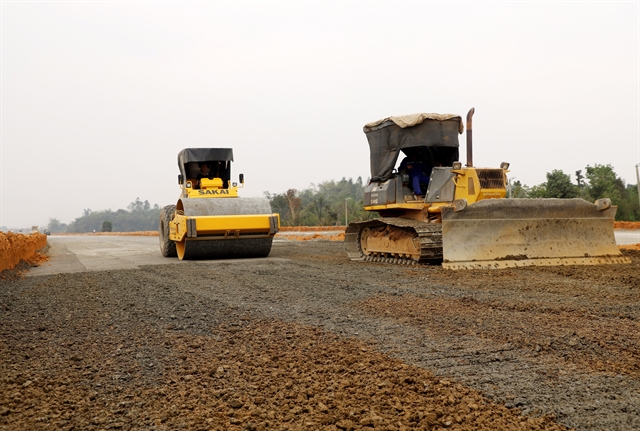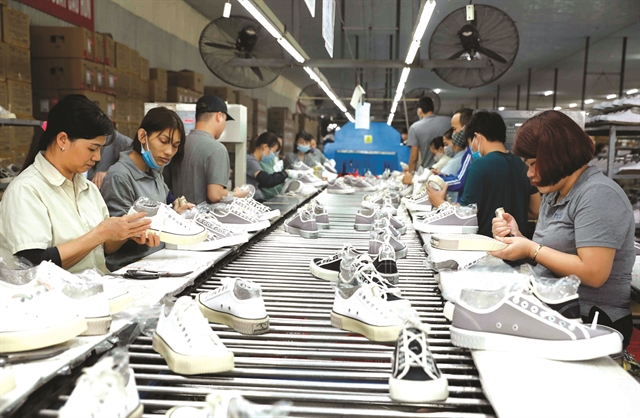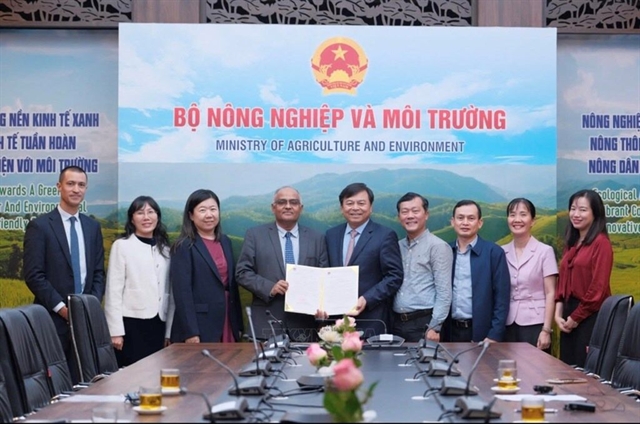 Economy
Economy

 |
| Production of shoes exported to the EU market at Hà Tây Textile Chemical Co, Ltd, Hà Nội. VNA/VNS Photo Trần Việt |
HÀ NỘI — The footwear industry must implement solutions on sustainable development to fulfil the goals in a development strategy for Việt Nam's garment-textile and footwear industries to 2030, with a vision to 2035, according to experts.
This development strategy sets the goal of turning Việt Nam into a country that produces export textiles, garments and footwear, meeting requirements for sustainable development.
Việt Nam also targets to reach a total export turnover of footwear and handbags of US$38-40 billion by 2030. The industry by 2035 will have sustainable development according to the green economy model, complete the domestic production value chain, and effectively participate in the global value chain. It will develop a number of regional and world brands.
Diệp Thành Kiệt, vice chairman of the Việt Nam Leather, Footwear and Handbag Association (LEFASO), said that to achieve the goals of the strategy, Vietnamese leather and footwear enterprises must focus on the standards of sustainable development.
When the EU's carbon border adjustment mechanism (CBAM) comes into effect, Vietnamese enterprises cannot export to Europe if their products do not satisfy CBAM's criteria, even if these products meet the requirements under the EU-Vietnam Free Trade Agreement (EVFTA).
At the same time, enterprises must develop their ability to design products and reduce production costs to the lowest level.
Meanwhile, the Government needs to issue policies on encouraging localisation of raw materials, and implementing the standards on sustainable development.
According to Nguyễn Ngọc Hòa, chairman of the HCM City Union of Business Associations (HUBA), the development of a green economy is mandatory not only for businesses but also for the whole economy.
Sustainable development is not a burden, but an investment in opportunities for business in the future. Some businesses have received many orders after complying with the green production process.
Senior economist Nguyễn Minh Phong said the domestic carbon credit market would pilot operation from 2025 and operate officially in 2028 under international commitments. This market promises to create an impetus for Vietnamese businesses to move towards low-emission production. Enterprises with great emission reduction potential at low cost could immediately invest in converting to emission reduction technologies.
According to the observation of Maxime Rogeon, head of the Footwear Team, at Decathlon Vietnam, Việt Nam has many advantages, such as large export markets thanks to FTAs and domestic material supply at 50 per cent of demand. Besides that, almost all of the world's major footwear manufacturers have developed production facilities in Việt Nam. However, this country needs solutions for green logistics, sourcing and faster shipping.
Việt Nam's leather and footwear industry also needs policies to encourage the application of artificial intelligence technology in production.
Additionally, Việt Nam needs to restructure the footwear industry and apply sustainable production and business models that save production costs.
Lê Hùng Cường, digital director of FPT Digital, a subsidiary of FPT Corporation, recommended that footwear businesses needed to participate in shared ecosystems, thereby taking advantage of big data.
The digital transformation process needs to ensure safety for company data but also customer data, according to Cường.
Businesses also need to pay attention to optimising customer experience and interactions for all stages of the business process.
At present, about 65 per cent of Việt Nam's footwear production capacity is concentrated in the Southeast region. The percentage is 16 per cent in the Red River Delta; 15 per cent in the Mekong Delta; 3 per cent in the North Central and Central Coast regions; and 1 per cent in the Northern mountainous region.
Of which, the Southeast region and the Mekong River Delta have a tendency to reduce production capacity. The North Central Coast, Central Coast and Mekong River Delta are on an increasing trend.
Therefore, businesses and investors should pay attention to these trends if they want to expand production, otherwise, it will not be easy to find workers, according to experts.
Kiệt said LEFASO had developed an export scenario for 2023. In the optimistic scenario, production will recover from the third quarter, and the footwear industry's export turnover is expected to reach $25.8 billion this year, down 7.5 per cent compared to last year.
In another scenario, production will be restored in the fourth quarter of 2023. This year's export turnover is expected to reach $25 billion, down 10.5 per cent compared to 2022.
In a negative scenario, by the fourth quarter of this year, production has not yet recovered, so the export turnover is predicted to reach $24.4 billion, down 14.5 per cent compared to 2022. VNS




